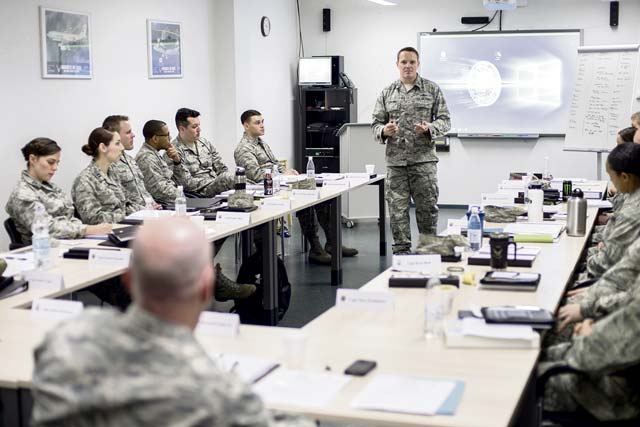
The 521st Air Mobility Operations Wing hosted a three-day Flight Commander and Officer in Charge Leadership Development Course to prepare young officers from the 521st AMOW, the 86th Airlift Wing and the 435 Air Ground Operations Wing for their new roles and responsibilities Oct. 16 to 18.
New commissioned officers often take on leadership roles where they are responsible for an entire section of their squadron. Commonly, enlisted Airmen make up the majority of these flights. While officers do receive training for basic leadership skills and specific training for their respective jobs, the Flight Commanders Course dives deeper and focuses on critical leadership knowledge and leadership philosophy.
“Lt. Col. Vandevere and I took a practical approach to this course,” said Capt. Justin Klawitter, 521st Air Mobility Operations Wing Cyberspace Operations chief. “In addition to covering the leadership development curriculum provided by Air Mobility Command, we coordinated supporting base agencies to give an overview of the services available to Airmen. We also had squadron commanders’ and first sergeants’ panels, and asked other former and current senior enlisted leaders to provide their perspectives on how to best take care of and grow Airmen.”
The course kicked off with a video of Gen. Carlton D. Everhart II, Air Mobility Command commander, giving an introductory speech for the students.
“As General Everhart pointed out in the welcome video, people are our most valuable weapon system, and it’s important for leaders to create an environment where Airmen can develop and grow,” said Klawitter. “This additional expectation is levied on those officers selected for flight commander and officer in charge roles so it’s important for them to hone their ability to do just that.”
Students found the training to be insightful.
“In just three days, I think we all gained significant mentoring, concrete skills and methods, knowledge of resources, and were challenged to think deeply about our roles as future commanders and leaders,” said Capt. Carrie Serjeant, 86th Medical Group executive officer and Flight Commanders Course student. “We covered a lot of practical information such as financial management, commander’s responsibilities, and the enlisted promotion system. But more importantly, we got to delve into critical thinking related to leadership, decision-making, and self-development as officers.”
Serjeant said the course gave her a better understanding of the impact she can have as a flight commander or OIC.
“I think we were encouraged to view leadership as an active, deliberate process; being present for those we lead, actively seeking feedback, and developing Airmen,” she said.
The Flight Commanders Course will continue to train and develop young officers into leadership roles.
“I hope that similar courses will be developed and offered in the future,” said Serjeant. “Having the opportunity to hear squadron and wing-level leadership perspectives in an open, candid environment was awesome.”


